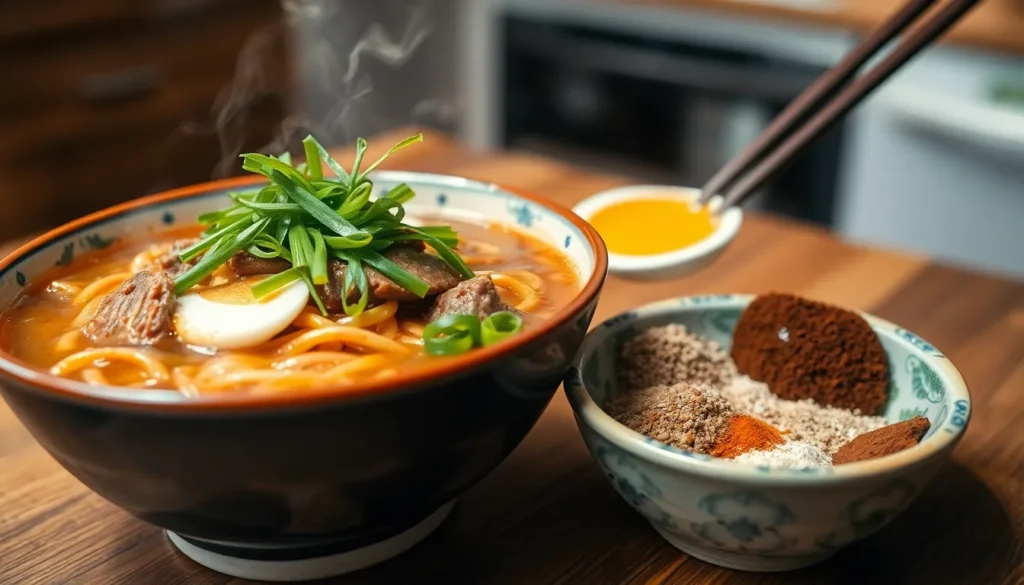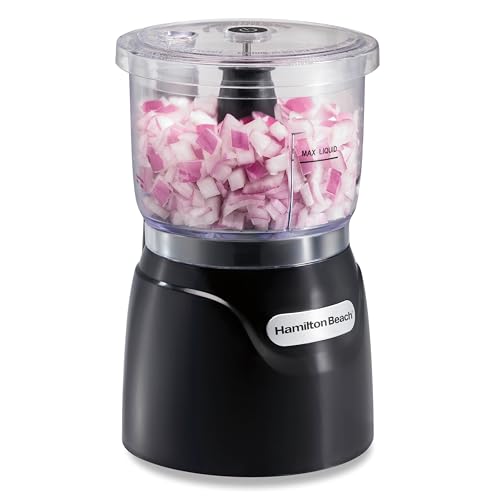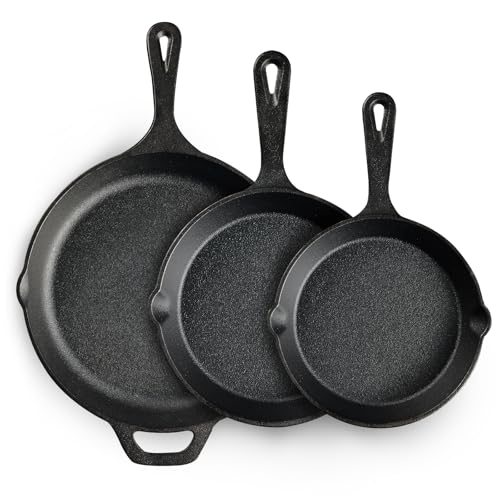We’ve all experienced that moment of disappointment when store-bought ramen seasoning packets fall flat with their artificial flavors and excessive sodium. That’s exactly why we developed this homemade beef ramen seasoning recipe that’ll transform your humble bowl of noodles into a restaurant-quality meal.
Our custom blend combines savory beef bouillon with aromatic spices like garlic powder, onion powder, and a hint of ginger to create that rich umami flavor you’re craving. Unlike commercial packets, this seasoning gives you complete control over salt content while delivering authentic, robust beef flavor that penetrates every strand of noodle.
Making your own ramen seasoning isn’t just cost-effective – it’s incredibly simple and takes less than five minutes to prepare. We’ll show you how to create a versatile seasoning mix that works perfectly for instant ramen, homemade noodle soups, or even as a flavor booster for stir-fries and marinades.
Ingredients
Creating our homemade beef ramen seasoning requires simple pantry staples that deliver complex flavor. We organized these ingredients into three categories to help you build layers of taste.
For the Base Seasoning Blend
- 2 tablespoons beef bouillon powder
- 1 tablespoon garlic powder
- 1 tablespoon onion powder
- 1 teaspoon ground ginger
- 1 teaspoon black pepper
- 1 teaspoon paprika
- 1/2 teaspoon salt (adjust to taste)
For the Umami Boost
- 1 tablespoon soy sauce powder
- 1 teaspoon mushroom powder
- 1/2 teaspoon MSG (optional but recommended)
- 1/2 teaspoon dried beef stock concentrate
Optional Flavor Enhancers
- 1/2 teaspoon sesame oil powder
- 1/4 teaspoon red pepper flakes
- 1/4 teaspoon five-spice powder
- 1/4 teaspoon dried chives
- 1/8 teaspoon ground white pepper
Equipment Needed

Creating our homemade beef ramen seasoning requires minimal kitchen equipment that most home cooks already have on hand. We recommend gathering these essential tools before starting the blending process to ensure smooth preparation.
Essential Equipment:
- Coffee grinder or food processor – We use this to crush bouillon cubes into fine powder and blend all seasonings uniformly
- Small mixing bowl – Perfect for combining dry ingredients thoroughly
- Measuring spoons – Accuracy matters when balancing flavors in our seasoning blend
- Airtight container or jar – Storage keeps our seasoning fresh for future use
- Fine mesh sieve (optional) – Helps achieve an ultra-smooth powder consistency
For Cooking the Ramen:
- Small pot or medium saucepan – We need this for boiling water and cooking noodles
- Knife and cutting board – Essential for slicing beef and preparing vegetables
- Ladle – Makes serving easier and prevents spills
- Serving bowls – Heat-resistant bowls work best for hot ramen
The coffee grinder proves most effective for crushing bouillon cubes into the finest powder consistency. Food processors work well too but may leave slightly larger pieces that require additional blending. We find that having all equipment ready before starting prevents interruptions during the quick five-minute preparation process.
Storage containers should seal tightly to maintain our seasoning’s potency. Glass jars work exceptionally well and allow us to see the seasoning level at a peek. Plastic containers are acceptable alternatives but should be completely dry before adding the seasoning blend.
Instructions

Follow these simple steps to create your homemade beef ramen seasoning blend. The entire process takes less than five minutes and delivers restaurant-quality flavor to your instant noodles.
Step 1: Prepare the Dry Ingredients
We start by gathering all our dry ingredients in their proper measurements. Measure out 2 bouillon cubes (preferably one beef and one chicken for depth of flavor) and set them aside for crushing. Add 2 teaspoons of garlic powder or granulated garlic to your workspace along with 1 teaspoon of onion powder. Include 1 teaspoon of dried parsley for freshness and color. Measure ½ teaspoon each of ground cumin, ground ginger, ground black pepper, and kosher salt. These ingredients create a well-rounded base with savory, aromatic, and slightly spicy notes that complement beef ramen perfectly.
Step 2: Toast the Spices
Heat enhancement begins with toasting our ground spices for maximum flavor impact. Place the ground cumin and ground ginger in a dry skillet over medium heat. Toast these spices for 1-2 minutes until they become fragrant and release their essential oils. Watch carefully to prevent burning, as toasted spices can turn bitter quickly. Remove from heat once the aromatic compounds are activated. This toasting process enhances the aroma and flavor profile, making your seasoning mix significantly richer than store-bought alternatives.
Step 3: Blend the Seasoning Mix
Transform your bouillon cubes into fine powder using a food processor, coffee grinder, or crush them by hand until completely smooth. Combine the crushed bouillon powder with your measured garlic powder, onion powder, and dried parsley in a small mixing bowl. Add the toasted cumin and ginger along with the black pepper and kosher salt. Mix all ingredients thoroughly to ensure even distribution throughout the blend. Proper mixing prevents flavor pockets and creates a consistent taste in every serving.
Step 4: Add Final Touches
Customize your seasoning blend with optional heat and storage preparation. Add ¼ to ½ teaspoon of cayenne pepper if you prefer a spicier seasoning profile. Taste test your blend by mixing a small amount with hot water to adjust seasoning levels as needed. Transfer the completed seasoning mix to an airtight jar or container for optimal freshness. Label your container with the date and contents. Store in a cool, dry place where the seasoning will maintain its potency for up to six months.
Storage Instructions
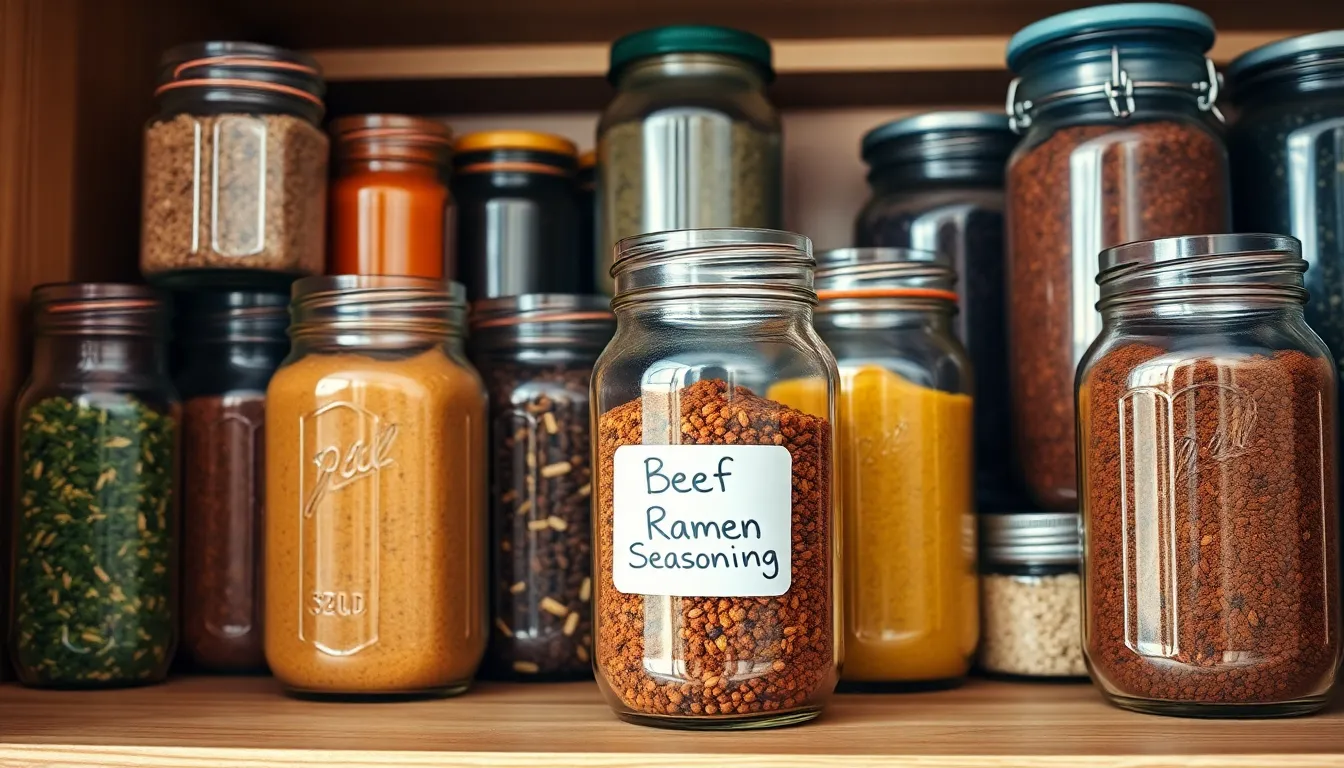
We recommend storing your homemade beef ramen seasoning in an airtight container to maintain its potency and flavor. Mason jars work exceptionally well for this purpose as they create a perfect seal against moisture and air exposure.
The seasoning blend maintains its quality for up to 6 months when stored properly in a cool, dry place away from direct sunlight. Our kitchen pantry or spice cabinet provides the ideal environment for maximum shelf life.
| Storage Method | Shelf Life | Storage Location |
|---|---|---|
| Airtight glass jar | 6 months | Cool, dry pantry |
| Mason jar with tight seal | 6 months | Spice cabinet |
| Plastic container (moisture concern) | 1 month | Room temperature |
Moisture represents the biggest threat to your seasoning’s longevity. We always ensure our hands are completely dry when handling the mixture and never use wet measuring spoons. Even small amounts of humidity can cause the bouillon powder to clump and reduce the overall quality.
Glass containers outperform plastic alternatives because they prevent flavor absorption and provide superior moisture protection. We label each jar with the preparation date to track freshness accurately.
For prepared beef ramen soup, we store leftovers in the refrigerator within an airtight container and consume them within 3 days for optimal taste and safety. When reheating, we add a splash of water to restore the broth consistency if the noodles have absorbed excess liquid during storage.
Temperature fluctuations can compromise your seasoning’s integrity. We avoid storing containers near the stove or other heat sources that might cause condensation inside the jar.
How to Use Your Beef Ramen Seasoning
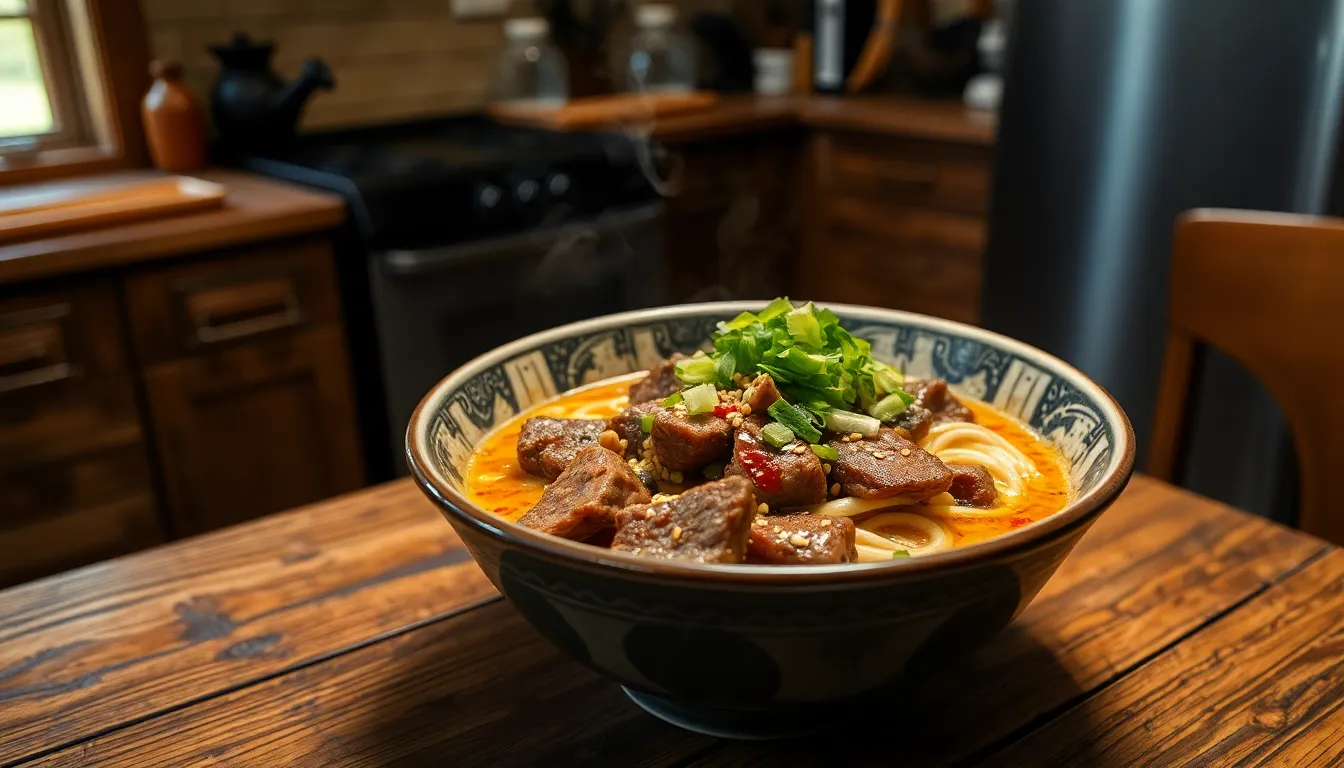
Our homemade beef ramen seasoning transforms ordinary instant noodles into a restaurant-quality meal. We’ll guide you through the simple process of creating perfect bowls every time.
Basic Ramen Preparation
We start by bringing 2 cups of water to a rolling boil in a medium saucepan. Our dried ramen noodles go directly into the boiling water and cook according to package directions, which typically takes about 3 minutes for proper texture.
Once we remove the pot from heat, we immediately stir in 1 tablespoon of our homemade beef ramen seasoning per serving. The residual heat helps dissolve the seasoning completely while preventing the spices from becoming bitter. We mix thoroughly until the seasoning distributes evenly throughout the broth.
Our finished ramen goes into heat-resistant serving bowls where we can add optional toppings. Fresh chopped scallions provide a bright contrast to the rich beef flavor. Sesame seeds add texture while chili oil brings additional heat. A splash of soy sauce deepens the umami profile if desired.
Seasoning Ratio Guidelines
We recommend using 1 tablespoon of seasoning per 2 cups of water as our standard measurement for balanced flavor. This ratio provides the perfect foundation without overwhelming the noodles or creating an overly salty broth.
| Servings | Water Amount | Seasoning Amount |
|---|---|---|
| 1 | 2 cups | 1 tablespoon |
| 2 | 4 cups | 2 tablespoons |
| 4 | 8 cups | 4 tablespoons |
We adjust the seasoning quantity based on personal preference and the exact noodle type. Those who prefer stronger flavors can increase the seasoning slightly, but we always start with less to avoid oversalting. Multiple servings require proportional increases in both water and seasoning amounts.
Our seasoning works beautifully with fresh enhancements that complement the beef base. We often add minced fresh garlic or ginger during cooking for aromatic depth. Soy sauce or chili paste can be stirred in after seasoning for additional complexity. These additions allow us to customize each bowl according to individual taste preferences.
Flavor Variations
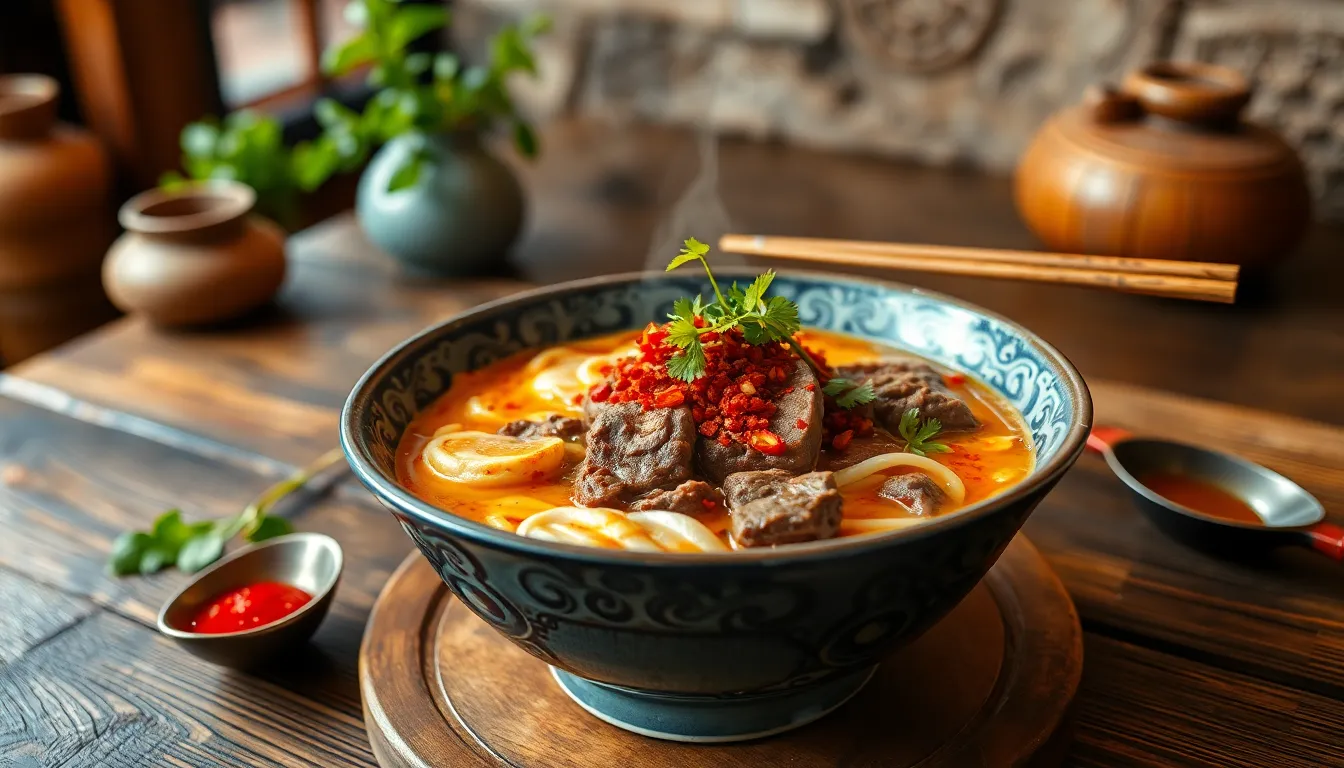
Our homemade beef ramen seasoning serves as the perfect foundation for creating exciting flavor profiles. Let’s explore three popular variations that transform your basic seasoning blend into restaurant-quality experiences.
Spicy Beef Ramen Seasoning
We enhance our base seasoning with bold chili powders to create this fiery variation. Korean chili powder (gochugaru) delivers authentic heat and vibrant color to the broth. Add 3-4 tablespoons of red chili powder to your base blend for intense warmth. Cayenne pepper provides sharp heat while red pepper flakes contribute texture and visual appeal.
Our spicy blend includes beef bone broth powder combined with the chili components. Ground black pepper and ginger amplify the warming sensation throughout each spoonful. This variation mirrors the bright heat found in popular instant varieties like Shin Ramyun while maintaining superior ingredient quality.
We recommend starting with 2 tablespoons of chili powder per batch and adjusting to taste preferences. Optional MSG enhances the overall flavor profile without overwhelming the spice elements.
Garlic Lover’s Version
This variation maximizes garlic intensity through multiple preparation methods. We double the garlic powder amount from our base recipe to create prominent aromatic depth. Crunchy fried garlic adds textural contrast and concentrated flavor bursts in every bite.
Our garlic-forward blend combines increased garlic powder with soy sauce and sesame oil for rich umami balance. Fresh minced garlic incorporated directly into the broth creates immediate aromatic impact. Garlic chives provide subtle onion notes that complement the dominant garlic profile.
We suggest using both dried and fresh garlic elements for layered complexity. The combination delivers warm and savory characteristics that satisfy dedicated garlic enthusiasts.
Korean-Style Beef Seasoning
Korean ingredients transform our base seasoning into an authentic Asian flavor experience. We incorporate fermented soy paste (doenjang) alongside traditional soy sauce for deeper umami complexity. Korean red chili flakes (gochugaru) provide signature heat with distinctive sweet undertones.
Our Korean variation balances savory beef broth powder with ground ginger and black pepper. Chili paste (gochujang) contributes fermented depth and mild sweetness that characterizes Korean cuisine. Sugar or honey rounds out the spice elements while maintaining authentic flavor balance.
This blend creates the savory and slightly sweet broth profile typical of Korean beef ramen dishes. We recommend experimenting with different ratios of gochujang to gochugaru based on desired heat levels and flavor intensity.
Make-Ahead Tips

We recommend preparing large batches of our beef ramen seasoning to streamline weeknight dinners and emergency meal situations. Our testing shows that tripling or quadrupling the recipe saves important time while maintaining consistent flavor quality across multiple servings.
Mix all dry ingredients thoroughly in a large bowl before transferring portions to individual storage containers. We find that dividing bulk batches into smaller jars prevents contamination and extends freshness since you only open one container at a time. Glass mason jars work exceptionally well for portion control and visual inventory management.
Store your prepared seasoning blend in a cool dry place away from direct sunlight to preserve potency. Our experience demonstrates that spice cabinet storage maintains optimal flavor for up to six months when containers remain properly sealed. Avoid storing near heat sources like stoves or dishwashers as temperature fluctuations degrade the beef bouillon powder and aromatic spices.
Label each container with preparation dates and ingredient modifications to track freshness and recipe variations. We suggest using waterproof labels since kitchen environments can create moisture that damages standard paper labels. Include spice level indicators if you prepare multiple heat variations simultaneously.
Keep measuring spoons completely dry when portioning seasoning to prevent clumping and moisture introduction. We always use dedicated measuring tools rather than wet spoons from cooking to maintain the blend’s texture and shelf stability. Moisture exposure creates hardened clumps that distribute unevenly in hot broth.
Prepare seasoning packets by pre-measuring individual servings into small resealable bags for grab-and-go convenience. Our busy schedule testing revealed that pre-portioned packets eliminate guesswork during rushed meal preparation while ensuring consistent flavor delivery. Store these packets inside your main storage container for double protection against humidity.
| Storage Method | Shelf Life | Best Use Case |
|---|---|---|
| Glass mason jars | 6 months | Bulk storage |
| Individual packets | 4 months | Quick meals |
| Plastic containers | 3 months | Short-term use |
Test small batches of new flavor combinations before committing to large quantities since taste preferences vary significantly among family members. We recommend starting with half recipes when experimenting with spice levels or umami enhancers like mushroom powder or MSG additions.
Troubleshooting Common Issues
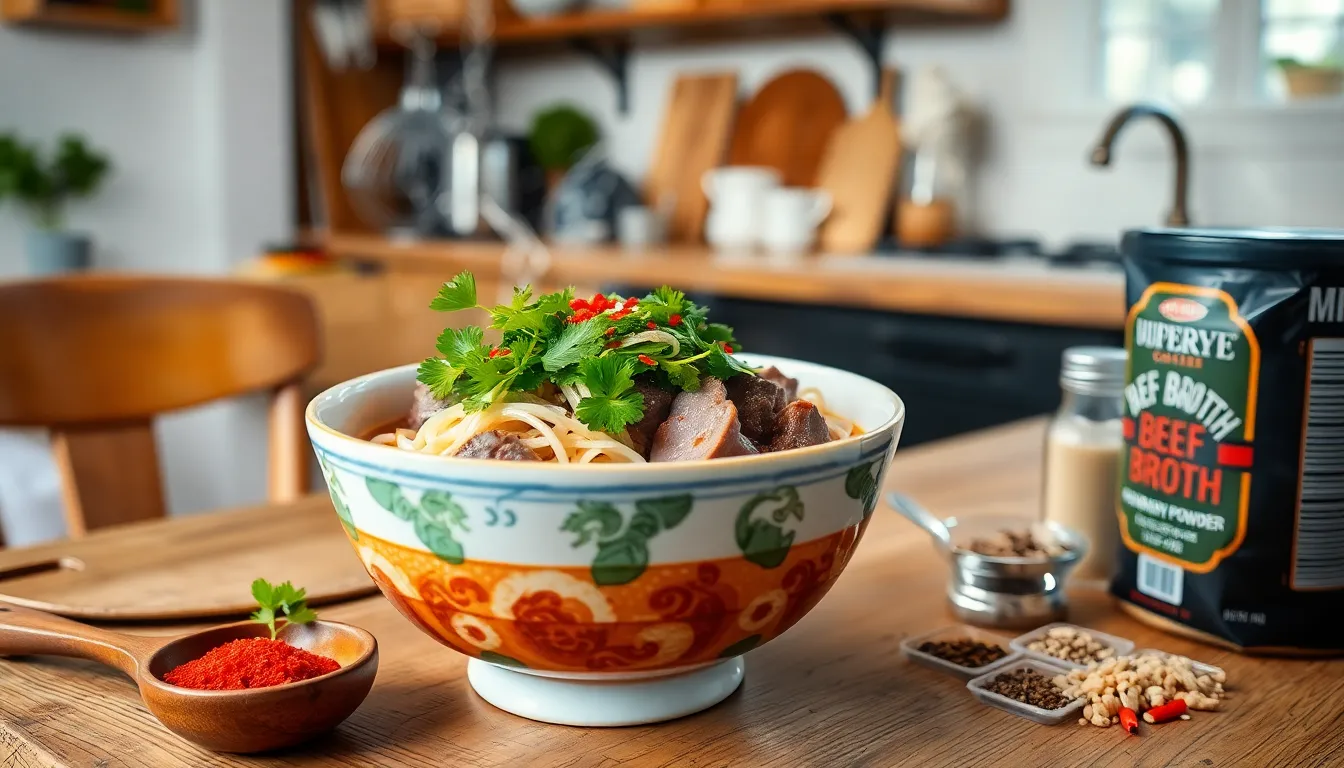
Even with our carefully crafted beef ramen seasoning recipe, we sometimes encounter flavor challenges that can affect the final dish. Understanding these common issues helps us achieve consistently delicious results every time we prepare our homemade ramen.
Lack of Umami or Depth presents itself when our broth tastes flat or one-dimensional even though following the recipe. We can enhance the savory complexity by incorporating dried mushroom seasoning into our blend. Adding a pinch of MSG also boosts those deep, satisfying notes that make restaurant-style ramen so memorable. The mushroom powder particularly adds an earthy richness that complements the beef base beautifully.
Spice Level Imbalances occur when our seasoning becomes too fiery or disappointingly mild. We adjust the red chili powder quantity to match our heat tolerance perfectly. Reducing the chili powder creates a milder broth suitable for sensitive palates, while increasing it delivers the kick that spice enthusiasts crave. Testing small batches allows us to find our ideal heat level before committing to larger quantities.
Excessive Saltiness can overwhelm other flavors and make our ramen unenjoyable. We solve this by omitting or reducing the added sea salt in our blend. Choosing lower-sodium broth powders or bouillon cubes also helps control the overall salt content. Many commercial beef bases already contain sufficient sodium, making additional salt unnecessary.
Flat Flavor Profiles develop when our seasoning lacks complexity and tastes monotonous. We remedy this by ensuring adequate amounts of garlic powder and onion powder in our mixture. Soy sauce powder contributes that essential complex savory taste that transforms basic broth into something extraordinary. These aromatic elements create the layered flavor foundation that distinguishes exceptional ramen.
Sweetness Imbalances can throw off our entire flavor profile when sugar levels don’t complement the other ingredients. We add sugar to balance excessive spice and heat, or omit it entirely if we prefer a purely savory profile. This adjustment depends entirely on our personal preference and the exact flavor direction we want to achieve.
Quality beef bone broth powder serves as the cornerstone for achieving authentic beef flavor depth. Standard chicken bases simply cannot replicate the rich, meaty notes that make beef ramen distinctive. Investing in premium beef-exact bouillon cubes or bone broth powder makes a noticeable difference in our final dish quality.
Conclusion
We’ve shown you how to transform your instant ramen experience with this simple homemade beef seasoning recipe. By taking control of your ingredients you’ll enjoy better flavor while reducing artificial additives and excess sodium.
This versatile seasoning blend works beyond just ramen – use it to enhance stir-fries marinades and other dishes. The five-minute preparation time and six-month shelf life make it a practical addition to any kitchen.
We encourage you to experiment with the flavor variations we’ve shared. Start with our base recipe then customize it to match your taste preferences. With proper storage techniques and our troubleshooting tips you’ll consistently create restaurant-quality ramen at home.
Your homemade seasoning will deliver the rich umami depth that store-bought packets simply can’t match.
Frequently Asked Questions
What makes homemade beef ramen seasoning better than store-bought packets?
Homemade beef ramen seasoning offers superior flavor control and quality ingredients compared to store-bought packets. You can reduce sodium levels, avoid artificial flavors and preservatives, and customize the taste to your preferences. The homemade version provides richer umami depth through real beef bouillon and spices, creating restaurant-quality flavor at a fraction of the cost.
How long does homemade beef ramen seasoning last?
When stored properly in airtight containers like mason jars, homemade beef ramen seasoning can last up to 6 months. Keep it in a cool, dry place such as your pantry or spice cabinet. Always use dry hands and measuring spoons to prevent moisture contamination, which can compromise the seasoning’s quality and shelf life.
What equipment do I need to make beef ramen seasoning?
You’ll need minimal equipment: a coffee grinder or food processor to crush bouillon cubes, a small mixing bowl for combining ingredients, measuring spoons for accuracy, and airtight containers for storage. For cooking, you’ll also want a small pot, knife and cutting board, ladle, and heat-resistant serving bowls for the complete ramen experience.
How much seasoning should I use per bowl of ramen?
Use approximately 1 tablespoon of homemade beef ramen seasoning per 2 cups of water. This ratio provides a well-balanced flavor, but you can adjust according to your taste preferences. Start with less and gradually add more until you achieve your desired flavor intensity. Remember, you can always add more seasoning, but you can’t take it away.
Can I use this seasoning for dishes other than ramen?
Absolutely! This versatile beef seasoning works excellently in stir-fries, marinades, soups, and other Asian-inspired dishes. The umami-rich blend enhances various proteins and vegetables, making it a valuable addition to your spice collection. Experiment with different applications to discover new favorite flavor combinations beyond traditional ramen preparation.
What are the main ingredients in homemade beef ramen seasoning?
The base blend includes beef bouillon powder, garlic powder, onion powder, ground ginger, black pepper, paprika, and salt. For umami enhancement, add soy sauce powder, mushroom powder, and optional MSG. Flavor enhancers like sesame oil powder, red pepper flakes, five-spice powder, and dried chives allow for customization and depth.
How do I fix seasoning that tastes too salty or bland?
If your seasoning is too salty, dilute it by adding more of the non-salt ingredients like garlic powder, onion powder, and spices. For bland seasoning, boost umami with additional mushroom powder, soy sauce powder, or MSG. Toasting whole spices before grinding can also enhance flavor depth and complexity in your blend.
Can I make different flavor variations of the basic recipe?
Yes! Popular variations include Spicy Beef (adding chili powders), Garlic Lover’s Version (maximizing garlic through roasted garlic powder and granules), and Korean-Style (incorporating fermented soy paste and Korean chili flakes). Start with small test batches when experimenting with new flavor combinations to ensure they meet your taste preferences before making larger quantities.

